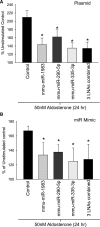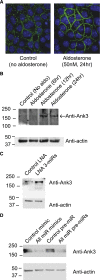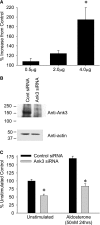Aldosterone regulates microRNAs in the cortical collecting duct to alter sodium transport
- PMID: 24744440
- PMCID: PMC4214524
- DOI: 10.1681/ASN.2013090931
Aldosterone regulates microRNAs in the cortical collecting duct to alter sodium transport
Erratum in
-
Erratum.J Am Soc Nephrol. 2015 Jun;26(6):1476. doi: 10.1681/ASN.2015040401. J Am Soc Nephrol. 2015. PMID: 26025913 Free PMC article. No abstract available.
-
Erratum.J Am Soc Nephrol. 2015 Oct;26(10):2600. doi: 10.1681/ASN.2015070789. J Am Soc Nephrol. 2015. PMID: 26424868 Free PMC article. No abstract available.
Abstract
A role for microRNAs (miRs) in the physiologic regulation of sodium transport in the kidney has not been established. In this study, we investigated the potential of aldosterone to alter miR expression in mouse cortical collecting duct (mCCD) epithelial cells. Microarray studies demonstrated the regulation of miR expression by aldosterone in both cultured mCCD and isolated primary distal nephron principal cells. Aldosterone regulation of the most significantly downregulated miRs, mmu-miR-335-3p, mmu-miR-290-5p, and mmu-miR-1983 was confirmed by quantitative RT-PCR. Reducing the expression of these miRs separately or in combination increased epithelial sodium channel (ENaC)-mediated sodium transport in mCCD cells, without mineralocorticoid supplementation. Artificially increasing the expression of these miRs by transfection with plasmid precursors or miR mimic constructs blunted aldosterone stimulation of ENaC transport. Using a newly developed computational approach, termed ComiR, we predicted potential gene targets for the aldosterone-regulated miRs and confirmed ankyrin 3 (Ank3) as a novel aldosterone and miR-regulated protein. A dual-luciferase assay demonstrated direct binding of the miRs with the Ank3-3' untranslated region. Overexpression of Ank3 increased and depletion of Ank3 decreased ENaC-mediated sodium transport in mCCD cells. These findings implicate miRs as intermediaries in aldosterone signaling in principal cells of the distal kidney nephron.
Copyright © 2014 by the American Society of Nephrology.
Figures








Similar articles
-
Aldosterone-induced microRNAs act as feedback regulators of mineralocorticoid receptor signaling in kidney epithelia.FASEB J. 2020 Sep;34(9):11714-11728. doi: 10.1096/fj.201902254RR. Epub 2020 Jul 11. FASEB J. 2020. PMID: 32652691 Free PMC article.
-
MicroRNA-19 is regulated by aldosterone in a sex-specific manner to alter kidney sodium transport.Am J Physiol Cell Physiol. 2024 Jan 1;326(1):C282-C293. doi: 10.1152/ajpcell.00385.2023. Epub 2023 Dec 4. Am J Physiol Cell Physiol. 2024. PMID: 38047299 Free PMC article.
-
A MicroRNA Cluster miR-23-24-27 Is Upregulated by Aldosterone in the Distal Kidney Nephron Where it Alters Sodium Transport.J Cell Physiol. 2017 Jun;232(6):1306-1317. doi: 10.1002/jcp.25599. Epub 2017 Jan 5. J Cell Physiol. 2017. PMID: 27636893 Free PMC article.
-
MicroRNAs and the regulation of aldosterone signaling in the kidney.Am J Physiol Cell Physiol. 2015 Apr 1;308(7):C521-7. doi: 10.1152/ajpcell.00026.2015. Epub 2015 Feb 11. Am J Physiol Cell Physiol. 2015. PMID: 25673770 Free PMC article. Review.
-
The epithelial sodium channel and the control of sodium balance.Biochim Biophys Acta. 2010 Dec;1802(12):1159-65. doi: 10.1016/j.bbadis.2010.06.014. Epub 2010 Jun 27. Biochim Biophys Acta. 2010. PMID: 20600867 Review.
Cited by
-
Specific Palmitoyltransferases Associate with and Activate the Epithelial Sodium Channel.J Biol Chem. 2017 Mar 10;292(10):4152-4163. doi: 10.1074/jbc.M117.776146. Epub 2017 Jan 30. J Biol Chem. 2017. PMID: 28154191 Free PMC article.
-
Physiological regulation of the epithelial Na+ channel by casein kinase II.Am J Physiol Renal Physiol. 2018 Mar 1;314(3):F367-F372. doi: 10.1152/ajprenal.00469.2017. Epub 2017 Oct 11. Am J Physiol Renal Physiol. 2018. PMID: 29021227 Free PMC article.
-
Aldosterone-induced microRNAs act as feedback regulators of mineralocorticoid receptor signaling in kidney epithelia.FASEB J. 2020 Sep;34(9):11714-11728. doi: 10.1096/fj.201902254RR. Epub 2020 Jul 11. FASEB J. 2020. PMID: 32652691 Free PMC article.
-
Lipopolysaccharide Inhibits Alpha Epithelial Sodium Channel Expression via MiR-124-5p in Alveolar Type 2 Epithelial Cells.Biomed Res Int. 2020 Mar 3;2020:8150780. doi: 10.1155/2020/8150780. eCollection 2020. Biomed Res Int. 2020. PMID: 32190682 Free PMC article.
-
MicroRNA-19 is regulated by aldosterone in a sex-specific manner to alter kidney sodium transport.Am J Physiol Cell Physiol. 2024 Jan 1;326(1):C282-C293. doi: 10.1152/ajpcell.00385.2023. Epub 2023 Dec 4. Am J Physiol Cell Physiol. 2024. PMID: 38047299 Free PMC article.
References
-
- Garty H, Palmer LG: Epithelial sodium channels: Function, structure, and regulation. Physiol Rev 77: 359–396, 1997 - PubMed
-
- Kellenberger S, Schild L: Epithelial sodium channel/degenerin family of ion channels: A variety of functions for a shared structure. Physiol Rev 82: 735–767, 2002 - PubMed
-
- Bhalla V, Hallows KR: Mechanisms of ENaC regulation and clinical implications. J Am Soc Nephrol 19: 1845–1854, 2008 - PubMed
Publication types
MeSH terms
Substances
Grants and funding
- R00 DK087922/DK/NIDDK NIH HHS/United States
- R01 DK047874/DK/NIDDK NIH HHS/United States
- P30-CA47904/CA/NCI NIH HHS/United States
- P30-DK079307/DK/NIDDK NIH HHS/United States
- R01-DK047874/DK/NIDDK NIH HHS/United States
- R01 DK091565/DK/NIDDK NIH HHS/United States
- R00-DK078917/DK/NIDDK NIH HHS/United States
- R01 LM009657/LM/NLM NIH HHS/United States
- R00-DK087922/DK/NIDDK NIH HHS/United States
- P30 DK079307/DK/NIDDK NIH HHS/United States
- R01-LM009657/LM/NLM NIH HHS/United States
- R00 DK078917/DK/NIDDK NIH HHS/United States
- P30 CA047904/CA/NCI NIH HHS/United States
LinkOut - more resources
Full Text Sources
Other Literature Sources

